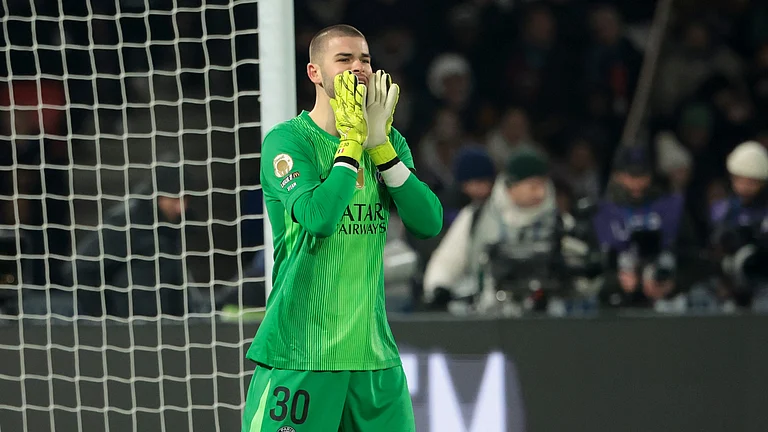In an unexpected space race, India and Russia are competing to be the first in the world to land on the South Pole of the Moon.
Russia last week launched Luna-25 Moon mission which might just beat India's Chandrayaan-3 to reach Moon. Even though the Luna-25 was launched weeks after Chandrayaan-3, it could land on Moon two days earlier.
The scheduled landing of Luna-25 is on August 21-23 and Chandrayaan-3 is also expected to land on August 23-24. The race becomes even more interesting as the South Pole of the Moon is the site where all key upcoming Moon missions are planned and all the world's space agencies would therefore be watching the Indian and Russian landings there. This also means that whichever country lands first achieves a historic first.
Here we explain what's Luna-25 mission and how it could beat Chandrayaan-3 to the South Pole of the Moon.
What's Luna-25, first Russian Moon mission in 5 decades?
Russia last Friday launched Luna-25 mission, which is its first Moon mission in nearly five decades. Russia's last Moon mission was in 1976.
In a post on Russian social media platform VK, Russian space agency Roscosmos said the Soyuz 2.1b rocket blasted off into space on Friday. The rocket carries the Luna-25 probe which will "analyse the soil, study the upper layer of regolith, and the lunar exosphere", according to the post by Roscosmos.
The Luna-25 probe is set to land on the South Pole of the Moon and the expected dates of landing is August 21-23.
The New York Times reported that the Luna-25, upon landing, will conduct experiments on Moon's South Pole for a year.
Experiments include scooping up soil samples and dig water-ice below the surface, reported NYT.
South Pole of the Moon is the region where the presence of ice was confirmed in 2008 by Chandrayaan-1 with the help of a US instrument aboard.
Russian Moon mission and national pride
Like India, Russia also attaches great pride with its space programme. Becoming the first in the world to land on the South Pole of the Moon in the midst of toughest sanctions so far would definitely boost Russian national pride. The NYT reported that Russian President Vladimir Putin holds the Soviet space programme in high regards and replicating that success now in the midst of Western sanctions is his priority and part of his agenda to restore Russia to its former glory.
The NYT reported, "In recent years under Mr. Putin’s rule, the Soviet era has been venerated as the apex of Russian power...The invasion of Ukraine has only amplified the weight of Mr. Putin’s quest to remake Russia. With Western sanctions and the war starving the country of foreign capital and technology, the moon launch is emerging as a marquee test of the country’s ability to chart a new path.
"It's a test that will be keenly watched around the world as Europe and America work to isolate Russia amid the war in Ukraine, and as Russia tries to strengthen its political and economic ties with non-Western countries in response. Mr. Putin sees Russia’s space program as one prong of that effort."
How could Luna-25 reach Moon before Chandrayaan-3?
Chandrayaan-3 was launched weeks before Russia's Luna-25 and yet the Russian spacecraft could land on Moon earlier.
There are two key reasons for that. One, Luna-25 weighs much lesser than Chandrayaan-3, so that it can travel faster. Two, Luna-25 can store more fuel, so it does not have any fuel efficiency concerns. Compared to Chandrayaan-3 weighing 3,900 kg, Luna-25 weighs just 1,750 kg.
The Indian Express reported that since Indian launch vehicle that delivered Chandrayaan-3 into space has lesser fuel-carrying capacity, the spacecraft had to take a more circuitous route that meant more time.
"After being launched around the Earth, the orbit of the spacecraft was increased in a series of manoeuvres to help it gain velocity. The spacecraft was then slingshot towards the moon, reaching the lunar orbit nearly 22 days after it was launched. Over the next few days, Chandrayaan-3 will reduce its orbit and velocity around to the moon in preparation for the soft landing likely to be attempted on August 23," says The Express.
On the other hand, when a spacecraft that does not have fuel efficiency concerns, it can go directly to the Moon without such circuitous route. That way, the time of the journey is reduced. The Print noted that it's not the first time that spacecraft launched after Indian craft would reach the destination first.
"The situation is reminiscent of the 2013-14 Martian launch season, when Indian Space Research Organisation (ISRO’s) Mangalyaan launched on 5 November, 2013, and reached Mars orbit on 24 September, 2014, while NASA’s Atlas V (Mars Atmosphere and Volatile Evolution or MAVEN) launched on 18 November, 2013, and entered Martian orbit on 21 September, 2014," reported The Print.
The Print added that while Mangalyaan took 10 days to 'raise orbit', MAVEN existed Earth orbit immediately upon launch and flew towards Mars at a greater speed. That's similar to what's happening now between Chadrayaan-3 and Luna-25.
The importance of Lunar South Pole landing
A major cause of excitement around India's Chandrayaan-3 was that it was set to be the first to land on the South Pole of the Moon, but that's likely not going to be the case anymore.
Landing on the South Pole is important as it is where ice has been confirmed and it is where future ambitious missions are supposed to land, including Artemis-III which would take humans to the Moon for the first time in five decades in next few years. This means that whichever spacecraft would land first would give that country a head start and its findings would be studied by all the space agencies.
"ISRO says that the lunar south pole is of special interest because parts of it remain permanently in shadow, raising the possibility of sampling Moon ice for the first time. Moreover, the large craters near the lunar south pole might contain clues to the composition of the early Solar System," noted TV Padma earlier in an article for Nature.
"The south pole region has very different geology from the region around the [US] Apollo missions, so Chandrayaan-3 will provide a close-up view of an entirely new region of the Moon," said planetary geochemist Marc Norman of the Australian National University in Canberra to Nature.
The Chandrayaan-1 in 2008 was intentionally crashed into the South Pole that confirmed the presence of water ice in a major discovery.
Space.com says, "Chandrayaan 1, which launched in October 2008, sent a moon orbiter aloft in India's first-ever deep-space effort. The orbiter carried a 64-pound (29 kilograms) impactor probe that slammed hard (but intentionally) into the lunar surface near the south pole. The impactor detected water ice just before it crashed, a discovery matched by a NASA instrument aboard the Chandrayaan 1 orbiter called the Moon Mineralogy Mapper.


























